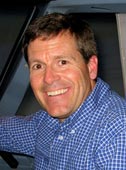Improving Patient Safety: Lessons from the Airline Industry

Mark Auerman
|
The important 2000 study of the Institute of Medicine in the United States "To Err
is Human" estimates that there are 50 to 99 thousand deaths per year related to
medical error in the US. At a recent UHN Surgical Services Rounds Captain Mark Auerman,
an Air Canada pilot specializing in competence assessment and training, opened the
discussion of patient safety with a slide illustrating a dramatic reduction of the
incidence of aircraft accidents. Over the past thirty years it has fallen from over
forty to fewer than two per thousand departures. He analyzed the "runway excursion"
of an Air France plane last year in Toronto which almost resulted in a highway incursion.
The cause was pilot error. Errors in the airline industry are primarily caused by
problems within the crew (66%). Only 13% are from problems with the airplane. Mark,
a nineteen-year veteran pilot, startled everyone by stating "I've never had a perfect
flight". This reflects the contrast between the culture of his industry, which plans
on coping with imperfection, and the misleading culture of perfectionism in surgery.
Competence of airline pilots is regulated. They are required to undergo a medical
examination every six months after the age of forty. They retire at age sixtyfive
-- age sixty at Air Canada. They undergo six training/ evaluation sessions per year,
including four days of simulator training and regular line operational safety checks
in the air, conducted by a pilot/evaluator "in the jumpseat". They spend a classroom
day with the full crew as part of the program of training in crew resource management.
The pilot's role is similar to that of the anaesthetist -- extremely busy at the
beginning and the end of the case. Though technology allows pilots to "fly by the
button" there has been recent emphasis on manual flying, to be sure they can manage
unexpected and unprogrammable emergencies.
Challenging personalities are managed by one-on-one training. Oversight includes
air safety reports, flight data analyses and the advanced qualification program.
The flight data analyses use de-identified data. The flight data recorder is retrieved
if variants are found, like "tail strikes" on take-off or landing.
|
The problems
of individual pilots are discovered in the simulators. The union is the gatekeeper
overseeing safety, a wise tradition that dates back to the guilds. Those who are
not able to meet the standard are taken off revenue flying. The training intervals
are based on data and experience, as some pilots take off several times per day,
and others may take off once and fly for nineteen hours. The mantra of the training
program is "we fly the way we train and train the way we fly."
Line operational safety audits look at "threats" as well as errors. The safety barriers
in James Reason's Swiss cheese diagram are: 1. Policies and procedures, for example,
"disarm the doors and cross check" (to be sure ground personnel are not injured
by emergency slides inflated like airbags when they open the doors); 2. Checklists;
3. Automation, though equipment can vary; 4. Crew resource management skill; and
5. Aircraft handling skill. The threats to the safety of the plane come from weather,
fatigue, malfunction, illness and complacency. When accidents occur despite all
of these safety barriers, the euphemism describing them is "undesirable aircraft
state", analogous to our "adverse event" terminology.
CULTURAL CHANGE
Air safety reports are kept confidential and no disciplinary action is taken on
the basis of these reports. The integrated safety management system includes self-reporting,
timely feedback to the initiators of the report, audit, and quality assurance. Important
elements of the cultural change in air safety include emphasis on these values:
1. We must recognize we make mistakes and devise ways to recognize, manage and prevent
them; 2. Training must be skill-based; 3. Crew performance, not just individual
performance must be strengthened; 4. Fatigue is managed by a 13-hour "duty gate".
This is important because pilots are paid more when they are in the air, analogous
to fee for service payment for performing surgery.
Air Canada spends roughly half of its budget on people and half on fuel and equipment.
Pilots grade each other using videos. Aging pilots have "naturalistic decision-
making" which is somewhat like surgical intuition. Their decisions are quicker and
more often right.
M.M.
|